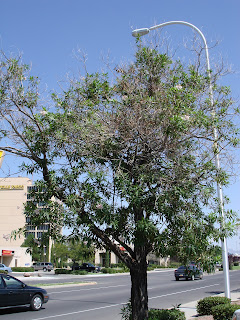 |
| A chitalpa tree infected with Xylella fastidiosa, the causal agent of bacterial leaf scorch (Photo: NMSU-PDC) |
Featured Diagnosis - Bacterial Leaf Scorch of Chitalpa. Over the past week, several chitalpa samples have been submitted to the NMSU Plant Clinic exhibiting symptoms of leaf necrosis. Chitalpa trees (a hybrid between catalpa and desert willow) are susceptible to a xylem-limited bacterium called Xylella fastidiosa. The bacterium invades the plant and plugs up the water conducting vessels, known as the xylem vessels, making it difficult for the plant to get enough water to the leaves. The result on the plant is symptoms of water and nutrient stress - chlorosis and leaf scorch. Other symptoms include leaf spotting, small leaves, thin canopy, branch dieback, and eventually, tree death. This disease was first discovered in New Mexico in 2006. It was also confirmed in grapes the same year. In grapes, the disease is known as Pierce’s Disease. In 2010, the disease was also confirmed in catalpa and peach. The disease is transmitted from one plant to another through xylem-feeding insects, most notably sharpshooters. While New Mexico has some native sharpshooters, the most efficient vectors for Xylella, the glassy-winged sharpshooter and the smoke-tree sharpshooter, are not know to occur.
 |
| Bacterial leaf scorch symptoms on chitalpa leaves (Photo: NMSU-PDC) |
 |
| Disease progression - the same tree photographed in August 2006 and October 2006 (Photo: NMSU-PDC) |

No comments:
Post a Comment